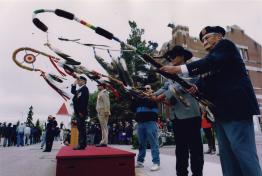
Don Healy (Regina Leader-Post)
Greg Rainville remembered, “I was punished because the nuns would get frustrated with you when they talk to you in French and English, and you’re not knowing what they’re talking about, and you’re pulled around by the ear, and whatnot, and slapped on the back of the head, and stuff like that. And I didn’t know what I was doing wrong. No matter what, I tried to do good, but I couldn’t understand what they were saying, and they couldn’t understand what I was saying, but I was punished.13 (TRC. Vol 5., p. 106)
Students who were hospitalized sometimes never returned. Greg Rainville recalled a friend passing out in church next to him. “I didn’t know where he went, because he never come back to school. I haven’t seen that guy ever since. I don’t know if he died, or he went to Fort Qu’Appelle, where there’s a hospital, ’cause a lot of times we should have been put in the hospital.”670 (TRC, Survivors Speak, p. 180)
In 1969, the federal government restructured the residential school system. The schools usually were divided into two, separate entities: a government-run school and a church-administered residence. Beginning in the 1970s, agreements were reached under which Aboriginal organizations took over the operation of several of the institutions. Greg Rainville attended the Qu’Appelle school while these transformations were taking place.
I’ve seen the, where the priests and nuns controlled the school. I was there when Indian Affairs took control of the residential school, and was there when Native Control started. But the most, the nuns there, when the nuns and the priests were there, there was, things got better after they left. They weren’t perfect, but there was still abuse when Indian Affairs control. A lot of things were, weren’t addressed, or, or made known to people, ’cause it was always hush-hush.
Rainville said the change from church to Indian Affairs administration brought about an improvement in personal freedom and food at the school.
When the nuns were there, we were just like a jail. There was a big fence all around. You couldn’t leave. Yeah, we had black and white tvs. We had, we didn’t go no place. Everything that we had was either outside in the yard, or in the gym. But when Indian Affairs got there, we, we were allowed to go maybe downtown to the hardware store, where we would have pop at the, in the café there in Lebret. You were allowed to do that. Before you weren’t even allowed to go. You know if you’re caught downtown, you were in trouble. But there was a lot more freedom. We used to get to go to drive-ins, movies.
When the nuns were there, everything was just, I don’t know, everything was hamburger-based. Everything was we ate the whole year was either mush, hamburgers, whatever, maybe the odd chicken, or odd ham. But with Indian Affairs, our food started, like, we had pork chops, we had boiled potatoes, stuff you could identify. Like, then when Native Control came to be, again we were back to hamburger, like, you know, from hamburger to steak, to hamburger again. That was, that’s the only way I could describe the different times people were there.730 (TRC, Survivors Speak, pp. 198-199)
TRC, AVS, Greg Rainville, Statement to the Truth and Reconciliation Commission of Canada, Saskatoon, Saskatchewan, 22 June 2012, Statement Number: 2011-1752.